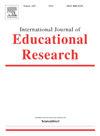Will what helps now help later? The role of school spending in shaping academic resilience and future success for Norway’s disadvantaged students
IF 2.5
3区 教育学
Q1 EDUCATION & EDUCATIONAL RESEARCH
引用次数: 0
Abstract
Academic resilience, which describes how disadvantaged students excel in schools, has gained attention for its potential to narrow achievement gaps and reduce educational inequalities. While malleable protective factors in the learning environment have been extensively studied, institutional factors like school spending have received less attention. This study utilizes Norwegian register data to examine how the amount and allocation of school spending may influence academic resilience through regression analyses. Instrumental variable (IV) analyses are then used to further examine support for the relationship between academic resilience and long-term outcomes, such as educational attainment and income by age 30. The findings reveal that class size and student-teacher ratios, while not predictors of academic resilience, are associated with long-term outcomes. The amount of school spending influences academic resilience; however, its effects on educational attainment and income vary. The allocation of school spending influences educational attainment and income, with specific investments in Norwegian language and special education support significantly predicting academic resilience. Academic resilience is predictive of both educational attainment and income, showing a more pronounced relationship with educational attainment. The IV analyses show consistent results. This study contributes to the literature by detailing the influence of school spending on academic resilience and its connection to future success, thus supporting policy development aimed at fostering social inclusion.
现在有用的东西以后会有用吗?学校支出在塑造挪威弱势学生的学业弹性和未来成功方面的作用
学业弹性指的是弱势学生如何在学校表现出色,它因其缩小成绩差距和减少教育不平等的潜力而受到关注。虽然学习环境中的可塑保护因素已经得到了广泛的研究,但像学校支出这样的制度性因素却很少受到关注。本研究利用挪威注册数据,通过回归分析来检验学校支出的数量和分配如何影响学业弹性。然后使用工具变量(IV)分析进一步检验学业弹性与长期结果(如30岁时的受教育程度和收入)之间关系的支持程度。研究结果显示,班级规模和师生比例虽然不是学业弹性的预测指标,但与长期结果有关。学校支出的多少影响学业弹性;然而,它对受教育程度和收入的影响各不相同。学校支出的分配影响教育成就和收入,在挪威语和特殊教育支持方面的具体投资显著预测学业弹性。学业弹性对受教育程度和收入都有预测作用,其中与受教育程度的关系更为明显。IV分析显示一致的结果。本研究通过详细说明学校支出对学业弹性的影响及其与未来成功的联系,从而支持旨在促进社会包容的政策制定,从而为文献做出了贡献。
本文章由计算机程序翻译,如有差异,请以英文原文为准。
求助全文
约1分钟内获得全文
求助全文
来源期刊

International Journal of Educational Research
EDUCATION & EDUCATIONAL RESEARCH-
CiteScore
6.20
自引率
3.10%
发文量
141
审稿时长
21 days
期刊介绍:
The International Journal of Educational Research publishes regular papers and special issues on specific topics of interest to international audiences of educational researchers. Examples of recent Special Issues published in the journal illustrate the breadth of topics that have be included in the journal: Students Perspectives on Learning Environments, Social, Motivational and Emotional Aspects of Learning Disabilities, Epistemological Beliefs and Domain, Analyzing Mathematics Classroom Cultures and Practices, and Music Education: A site for collaborative creativity.
 求助内容:
求助内容: 应助结果提醒方式:
应助结果提醒方式:


